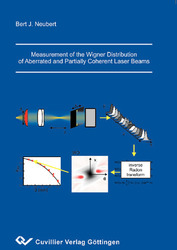| Departments | |
|---|---|
| Book Series (96) |
1378
|
| Nachhaltigkeit |
3
|
| Gesundheitswesen |
1
|
| Humanities |
2362
|
| Natural Sciences |
5406
|
| Mathematics | 229 |
| Informatics | 319 |
| Physics | 980 |
| Chemistry | 1363 |
| Geosciences | 131 |
| Human medicine | 243 |
| Stomatology | 10 |
| Veterinary medicine | 108 |
| Pharmacy | 147 |
| Biology | 835 |
| Biochemistry, molecular biology, gene technology | 121 |
| Biophysics | 25 |
| Domestic and nutritional science | 45 |
| Agricultural science | 1004 |
| Forest science | 201 |
| Horticultural science | 20 |
| Environmental research, ecology and landscape conservation | 148 |
| Engineering |
1790
|
| Common |
97
|
|
Leitlinien Unfallchirurgie
5. Auflage bestellen |
|
Advanced Search
Measurement of the Wigner Distribution of Aberrated and Partially Coherent Laser Beams (English shop)
Bert Neubert (Author)Preview
Table of Contents, Datei (60 KB)
Extract, Datei (84 KB)
Bert John Neubert, Measurement of the Wigner Distribution of Aberrated and Partially Coherent Laser Beams
The emission of a high-power semiconductor laser is partially coherent, and has to be described by appropriate means, e. g. a Wigner distribution.The Wigner distribution of a beam can be obtained experimentally from its power density profiles as the beam propagates. As this method is comparatively new, it was tested using a helium neon laser beam. The projected power density profiles were measured with a moving slit system. A cylindrical-spherical aberration was added to the beam using a plano-convex cylindrical lens. Measurements were carried out at different levels of aberration. The coefficients of cylindrical-spherical aberration, reconstructed from the Wigner distribution, deviated less than 30 % from the expected values. The coefficients of spherical aberration obtained from an experiment using a rotationally symmetric plano-convex lens agreed within 25 % of the expected values for high levels of aberration. For small levels of aberration, the aberration coefficients were strongly underestimated. The sources of error in the measurement were analyzed. In an experiment comparing the two methods at a high level of spherical aberration, the Wigner based approach turned out to be at least as good as standard Shack-Hartmann wavefront detectors.The propagation of a Gaussian beam with a cylindrical-spherical aberration was investigated numerically. The calculations show that the iterative beam width calculation, proposed in the new ISO standard, leads to an underestimation of the M² of a spherically aberrated beam. A formula for the impact of diffraction, aberration, and coherence on the beam propagation ratio, M², of an arbitrary beam was derived.The output of a tapered semiconductor laser diode, designed for high-power material processing applications, was investigated. The lateral (slow axis) M²?value rose from 1.5 to 3 as the current was increased from 1 A to 3 A. The Wigner distributions in the lateral (slow axis) direction at 1 A, 1.5 A, and 2 A were measured. The diffraction, aberration, and coherence related contributions to M², obtained from the Wigner distribution, were analyzed. At 1 A, the diffraction related contribution dominates. All contributions rise as the current is increased. At 2 A, the contribution, related to the reduction of coherence, dominates.
| ISBN-13 (Printausgabe) | 3865371612 |
| ISBN-13 (Hard Copy) | 9783865371614 |
| ISBN-13 (eBook) | 9783736911611 |
| Language | German |
| Page Number | 156 |
| Edition | 1 Aufl. |
| Volume | 0 |
| Publication Place | Göttingen |
| Place of Dissertation | Hamburg |
| Publication Date | 2004-07-28 |
| General Categorization | Dissertation |
| Departments |
Physics
|








